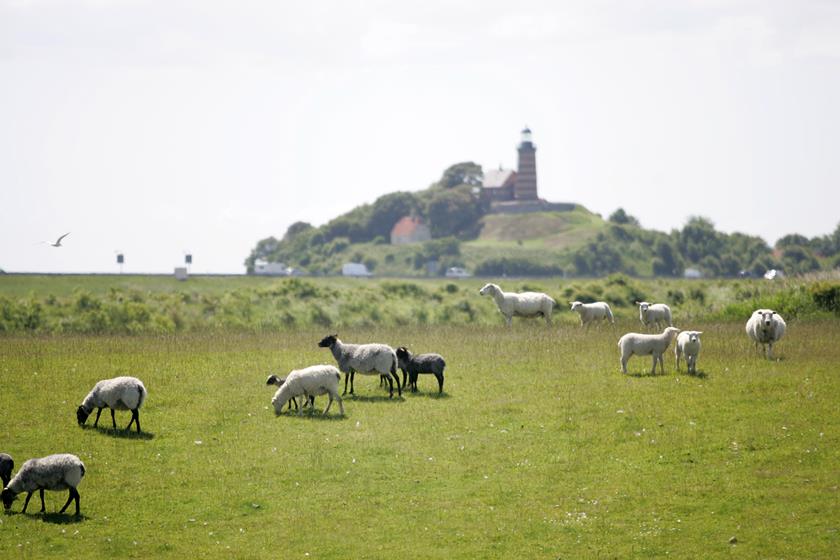King Valdemar's watchtower
Why did King Valdemar the Great build a castle on Sprogø? There was a good reason. A castle meant security - a place to store taxes and to imprison enemies. A resting place when travelling around the kingdom. Furthe it was a place of shelter if attacked.
Moreover, in times of unrest castles serve as points of attack and thre was plenty of unrest in the age of Valdemar the Great. Kings Sven, Knud and Valdemar fought for control of the Danish kingdom with Valdemar ruling Jutland, Knud Funen and Sven Zealand. This arrangement was to be celebrated at a feast in Roskilde on 9 August 1157, but King Sven used the opportunity to try to seize total power. King Knud was killed but Valdemar, though badly wounded, managed to flee to nearby Fjenneslev and then to Jutland, gathering and army near Viborg to were Sven pursued him. During the subsequent battle at Grathe Moor, south of Viborg, Valdemar defeated Sven, who fled but was recognised by a group of peasants who killed him. Thus Valdemar became the sole ruler of Denmark.
As well as the battles within the Danish borders, more importantly, perhaps, was the longstanding war with the Baltic Wends who had attacked and plundered the Danish coast for years.
Moreover, the Wends were heathens. Together with his commander, Bishop Absalon, Valdemar assembled a fleet of 260 ships to defeat the Wends once and for all. Crossing the Baltic Sea in rough weather, however, Valdemar became irresolute and ordered the fleet to seek shelter in the natural harbour at Fanefjord on the island of Møn. Biship Absalon, however, reprimanded the king for hesitating and after af few days' rest the fleet set sail againg for the famous battle on Rügen where the Danes conquered Arkona, the largest heathen fortress in Northern Europe and the departure point for the Wends' raids. For good measure, the Danish forces also destroyed the four-headed representation of the god Svantevit.
Visit Sprogø
Today, Sprogø is inhabited and closed to the public. Korsør and Nyborg tourist agencies arrange guided tours to the island.

Days of glory
So King Valdemar clearly needed points of support throughout Denmark for peacetime journeys as well as departure points for the raids against the Wends. Known as "Valdemar the Great" the king's reign heralded a golden period i Danish history, with agriculture prospering through large exports of cattle driven by cattlemen down through Jutland and sold in German towns. With the defeat of the Wends the attack on the Danish coast ceased and largely thanks to Valdemar Danish coast ceased and largely thanks to Valdemar Denmark became a united country for the first time.
The full extent of his influence is reflected in the fact that his children and their successors inherited the Danish throne, wheras previous kings had been elected.
It was during Valdemar's reign that burned tiles were first employed as a building material. The Dannevirke fortifications near the present day border with Germany were built during this time as were fortresses at Korsør, Nyborg, Kalundborg, Vordingborg (of which the Goose Tower still remains) - and Sprogø.
Measuring only 26 by 29 metres, the castle on Sprogø cannot have contained many occupants. Whether it had its own lord of the castle is also unknown. Most of Sprogø castle was demolished around the year 1300 and the valuable tiles were used for other castles such as Nyborg and Korsør.
The Fyrrebakke
The 24 m high Fyrebakke with lighthouse has a certain historical interest and is today protected. The lighthouse from 1868 is built on the remains of an old castle from 1167 built by King Valdemar the Great. The ruins, which are the oldest dated fortifications in Denmark, have been restored by the Danish National Museum in collaboration with Sund & Bælt and today appear beautifully on the Fyrrebakke. In 2011, the restoration of the ruin was finally put to rest with the publication of a book that tells the story of Sprogø and Valdemar's castle. In 1997, the light in the lighthouse was switched on again after being switched off since 1980. Today, however, the lighthouse has no practical significance for ship traffic.